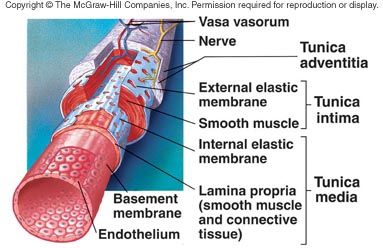Vascular histology quiz also useful for the histology questions on the USMLE step 1.
1.Which layer in an artery is primarily smooth muscle?
a. Tunica intima
b. Tunica media
c. Tunica externa
d. All of the above
e. None of the above
Answer: b
The tunica intima is the innermost layer of a blood vessel. It is lined by endothelium
The tunica media is the middle layer of a blood vessel. The tunica media is primarily smooth muscle.
The tunica externa or tunica adventitia is the outer layer of a blood vessel. In large vessels, the tunica adventitia contains vasa vasorum (blood vessels) and nervi vascularis (nerves).
2. A pronounced internal elastic membrane and external elastic membrane are distinguishing characteristics of which type of vessel?
a. Capillary
b. Arteriole
c. Venule
d. Elastic artery
e. Muscular artery
Answer: e
Capillaries are very thin walled in order to easily allow the exchange of gases. Gaseous exchange between the blood and tissues occurs at the level of the capillaries.
Arterioles are small branches of arteries with only one or two layers of smooth muscle in the tunica media. Arterioles regulate the amount of blood going into the capillary bed.
Venules are small branches of veins.
Elastic arteries are the arteries leaving the heart and the major branches. The aorta is an elastic artery.
Most of the named arteries are muscular arteries (with the exception of the aorta and the major branches off the aorta). The dividing line between elastic arteries and muscular arteries is not clear cut. However, a pronounced internal elastic membrane and external elastic membrane are distinguishing characteristics of muscular arteries.
Histology hint from Sarah Bellham: Elastic arteries also have an internal elastic membrane. However, there is so much elastic material in the tunica intima of an elastic artery, that a single, discrete internal elastic membrane is not visible.
3. Which of the following constitutes the microvascular bed of a tissue?
a. Capillaries
b. Capillaries and arterioles
c. Capillaries, arterioles, and post capillary venules
d. Capillaries, arterioles, post capillary venules, and veins
e. Capillaries, arterioles, post capillary venules, veins, and arteries
Answer: c
Capillaries, arterioles, and post capillary venules make up the microvascular bed of a tissue.
4. What are wide, leaky capillaries called?
a. Continuous capillaries
b. Fenestrated capillaries
c. Sinusoidal capillaries
d. AV anastomoses
e. Venous sinus
Answer: c
A characteristic of continuous capillaries is that things are transported across the epithelium via pinocytotic vesicles.
A characteristic of fenestrated capillaries is the presence of pores or fenestrae.
Sinusoidal capillaries (sinusoids) are wide leaky capillaries. They are found in the liver, spleen, and bone marrow.
An arteriovenous anastomoses (AV anastomoses or AV shunt) is a direct route between arteries and veins. It bypasses the capillary bed.
A venous sinus is a venous space lined by endothelium. A venous sinus surrounding the brain exists which is called the dural sinus.
5. What is a direct route between arteries and veins called?
a. Continuous capillaries
b. Fenestrated capillaries
c. Sinusoidal capillaries
d. AV anastomoses
e. Venous sinus
Answer: d
A characteristic of continuous capillaries is that things are transported across the epithelium via pinocytotic vesicles.
A characteristic of fenestrated capillaries is the presence of pores or fenestrae.
Sinusoidal capillaries (sinusoids) are wide leaky capillaries. They are found in the liver, spleen, and bone marrow.
An arteriovenous anastomoses (AV anastomoses or AV shunt) is a direct route between arteries and veins. It bypasses the capillary bed.
A venous sinus is a venous space lined by endothelium. A venous sinus surrounding the brain exists which is called the dural sinus.
6. Which layer in an elastic artery is the largest thickest?
a. Tunica intima
b. Tunica albuginea
c. Tunica externa
d. Tunica vaculosa
e. Tunica media
Answer: e
In an elastic artery, the tunica media is the thickest.
7. In which of the following is an arterial portal system found?
a. Kidney
b. Liver
c. Muscle
d. Brain
e. Stomach
Answer: a
The normal flow of blood is as follows: artery - arteriole - capillary - post capillary venule -vein. However, exceptions to this pattern of blood flow exist.
The phenomenon when a vein is between two capillary beds is called a venous portal system. An example of this is the hepatic portal system. Another example of a venous portal system is seen in the brain between the hypothalamus and pituitary.
The phenomenon when an arteriole is between two capillary beds is called an arterial portal system. This is seen in the kidney.
8. What are vasa vasorum?
a. Vasoactive material
b. Valves
c. Vasopressin secreting cells
d. Nerves
e. Blood vessels
Answer: e
Vasa vasorum are the blood vessels of the blood vessels. These are the vessels which supply the vessel wall.
9. Which structure has only a few layers of muscle in the tunica media?
a. Capillary
b. Arteriole
c. Elastic artery
d. Muscular artery
Answer: b
The tunica media is the middle layer of a blood vessel. The tunica media is primarily smooth muscle.
10. Which layer in a large vessel contains the nervi vascularis?
a. Tunica intima
b. Tunica media
c. Tunica externa
d. All of the above
e. None of the above
Answer: c
The tunica intima is the innermost layer of a blood vessel. It is lined by endothelium
The tunica media is the middle layer of a blood vessel. The tunica media is primarily smooth muscle.
The tunica externa or tunica adventitia is the outer layer of a blood vessel. In large vessels, the tunica adventitia contains vasa vasorum (blood vessels) and nervi vascularis (nerves).
source: Histology world

